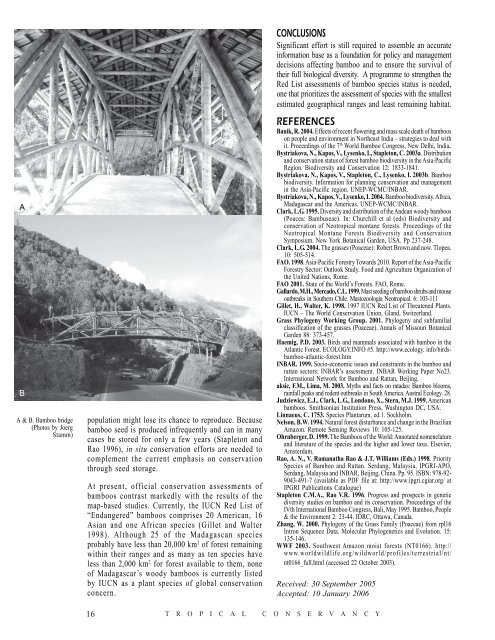Bamboo diversity: the need for a Red List review - UNEP World ...
Bamboo diversity: the need for a Red List review - UNEP World ...
Bamboo diversity: the need for a Red List review - UNEP World ...
You also want an ePaper? Increase the reach of your titles
YUMPU automatically turns print PDFs into web optimized ePapers that Google loves.
A<br />
B<br />
A & B. <strong>Bamboo</strong> bridge<br />
(Photos by Joerg<br />
Stamm)<br />
population might lose its chance to reproduce. Because<br />
bamboo seed is produced infrequently and can in many<br />
cases be stored <strong>for</strong> only a few years (Stapleton and<br />
Rao 1996), in situ conservation ef<strong>for</strong>ts are <strong>need</strong>ed to<br />
complement <strong>the</strong> current emphasis on conservation<br />
through seed storage.<br />
At present, official conservation assessments of<br />
bamboos contrast markedly with <strong>the</strong> results of <strong>the</strong><br />
map-based studies. Currently, <strong>the</strong> IUCN <strong>Red</strong> <strong>List</strong> of<br />
“Endangered” bamboos comprises 20 American, 16<br />
Asian and one African species (Gillet and Walter<br />
1998). Although 25 of <strong>the</strong> Madagascan species<br />
probably have less than 20,000 km 2 of <strong>for</strong>est remaining<br />
within <strong>the</strong>ir ranges and as many as ten species have<br />
less than 2,000 km 2 <strong>for</strong> <strong>for</strong>est available to <strong>the</strong>m, none<br />
of Madagascar’s woody bamboos is currently listed<br />
by IUCN as a plant species of global conservation<br />
concern.<br />
CONCLUSIONS<br />
Significant ef<strong>for</strong>t is still required to assemble an accurate<br />
in<strong>for</strong>mation base as a foundation <strong>for</strong> policy and management<br />
decisions affecting bamboo and to ensure <strong>the</strong> survival of<br />
<strong>the</strong>ir full biological <strong>diversity</strong>. A programme to streng<strong>the</strong>n <strong>the</strong><br />
<strong>Red</strong> <strong>List</strong> assessments of bamboo species status is <strong>need</strong>ed,<br />
one that prioritizes <strong>the</strong> assessment of species with <strong>the</strong> smallest<br />
estimated geographical ranges and least remaining habitat.<br />
REFERENCES<br />
Banik, R. 2004. Effects of recent flowering and mass scale death of bamboos<br />
on people and environment in Nor<strong>the</strong>ast India – strategies to deal with<br />
it. Proceedings of <strong>the</strong> 7 th <strong>World</strong> <strong>Bamboo</strong> Congress, New Delhi, India.<br />
Bystriakova, N., Kapos, V., Lysenko, I., Stapleton, C. 2003a. Distribution<br />
and conservation status of <strong>for</strong>est bamboo bio<strong>diversity</strong> in <strong>the</strong> Asia-Pacific<br />
Region. Bio<strong>diversity</strong> and Conservation 12: 1833-1841.<br />
Bystriakova, N., Kapos, V., Stapleton, C., Lysenko, I. 2003b. <strong>Bamboo</strong><br />
bio<strong>diversity</strong>. In<strong>for</strong>mation <strong>for</strong> planning conservation and management<br />
in <strong>the</strong> Asia-Pacific region. <strong>UNEP</strong>-WCMC/INBAR.<br />
Bystriakova, N., Kapos, V., Lysenko, I. 2004. <strong>Bamboo</strong> bio<strong>diversity</strong>. Africa,<br />
Madagascar and <strong>the</strong> Americas. <strong>UNEP</strong>-WCMC/INBAR.<br />
Clark, L.G. 1995. Diversity and distribution of <strong>the</strong> Andean woody bamboos<br />
(Poacea: Bambuseae). In: Churchill et al (eds) Bio<strong>diversity</strong> and<br />
conservation of Neotropical montane <strong>for</strong>ests. Proceedings of <strong>the</strong><br />
Neotropical Montane Forests Bio<strong>diversity</strong> and Conservation<br />
Symposium. New York Botanical Garden, USA. Pp 237-248.<br />
Clark, L.G. 2004. The grasses (Poaceae): Robert Brown and now. Tlopea.<br />
10: 505-514.<br />
FAO. 1998. Asia-Pacific Forestry Towards 2010. Report of <strong>the</strong> Asia-Pacific<br />
Forestry Sector: Outlook Study. Food and Agriculture Organization of<br />
<strong>the</strong> United Nations, Rome.<br />
FAO 2001. State of <strong>the</strong> <strong>World</strong>’s Forests. FAO, Rome.<br />
Gallardo, M.H., Mercado, C.L. 1999. Mast seeding of bamboo shrubs and mouse<br />
outbreaks in Sou<strong>the</strong>rn Chile. Mastozoologia Neotropical. 6: 103-111<br />
Gillet, H., Walter, K. 1998. 1997 IUCN <strong>Red</strong> <strong>List</strong> of Threatened Plants.<br />
IUCN – The <strong>World</strong> Conservation Union, Gland, Switzerland.<br />
Grass Phylogeny Working Group. 2001. Phylogeny and subfamilial<br />
classification of <strong>the</strong> grasses (Poaceae). Annals of Missouri Botanical<br />
Garden 88: 373-457.<br />
Haemig, P.D. 2003. Birds and mammals associated with bamboo in <strong>the</strong><br />
Atlantic Forest. ECOLOGY.INFO #5. http://www.ecology. info/birdsbamboo-atlantic-<strong>for</strong>est.htm<br />
INBAR. 1999. Socio-economic issues and constraints in <strong>the</strong> bamboo and<br />
rattan sectors: INBAR’s assessment. INBAR Working Paper No23.<br />
International Network <strong>for</strong> <strong>Bamboo</strong> and Rattan, Beijing.<br />
aksic, F.M., Lima, M. 2003. Myths and facts on ratadas: <strong>Bamboo</strong> blooms,<br />
rainfall peaks and rodent outbreaks in South America. Austral Ecology. 28.<br />
Judziewicz, E.J., Clark, L.G., Londono, X., Stern, M.J. 1999. American<br />
bamboos. Smithsonian Institution Press, Washington DC, USA.<br />
Linnaeus, C. 1753. Species Plantarum, ed.1. Sockholm.<br />
Nelson, B.W. 1994. Natural <strong>for</strong>est disturbance and change in <strong>the</strong> Brazilian<br />
Amazon. Remote Sensing Reviews 10: 105-125.<br />
Ohrnberger, D. 1999. The <strong>Bamboo</strong>s of <strong>the</strong> <strong>World</strong>: Annotated nomenclature<br />
and literature of <strong>the</strong> species and <strong>the</strong> higher and lower taxa. Elsevier,<br />
Amsterdam.<br />
Rao, A. N., V. Ramanatha Rao & J.T. Williams (Eds.) 1998. Priority<br />
Species of <strong>Bamboo</strong> and Rattan. Serdang, Malaysia, IPGRI-APO,<br />
Serdang, Malaysia and INBAR, Beijing, China. Pp. 95. ISBN: 978-92-<br />
9043-491-7 (available as PDF file at: http://www.ipgri.cgiar.org/ at<br />
IPGRI Publications Catalogue)<br />
Stapleton C.M.A., Rao V.R. 1996. Progress and prospects in genetic<br />
<strong>diversity</strong> studies on bamboo and its conservation. Proceedings of <strong>the</strong><br />
IVth International <strong>Bamboo</strong> Congress, Bali, May 1995. <strong>Bamboo</strong>, People<br />
& <strong>the</strong> Environment 2: 23-44. IDRC, Ottawa, Canada.<br />
Zhang, W. 2000. Phylogeny of <strong>the</strong> Grass Family (Poaceae) from rpl16<br />
Intron Sequence Data. Molecular Phylogenetics and Evolution. 15:<br />
135-146.<br />
WWF 2003. Southwest Amazon moist <strong>for</strong>ests (NT0166). http://<br />
www.worldwildlife.org/wildworld/profiles/terrestrial/nt/<br />
nt0166_full.html (accessed 22 October 2003).<br />
Received: 30 September 2005<br />
Accepted: 10 January 2006<br />
16 T R O P I C A L C O N S E R V A N C Y

















